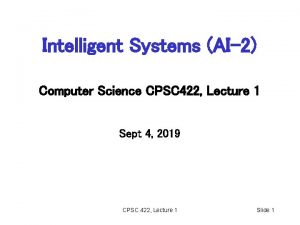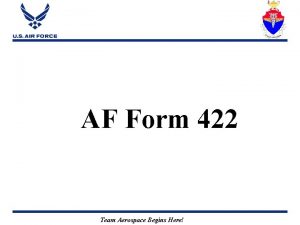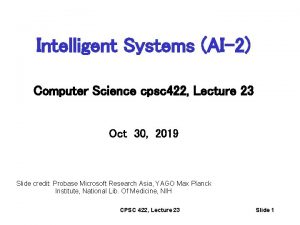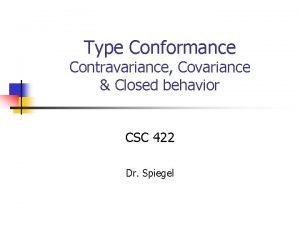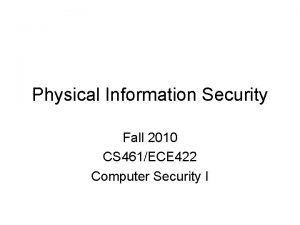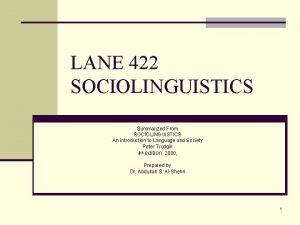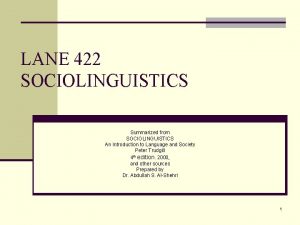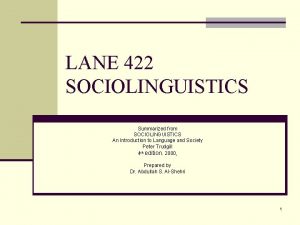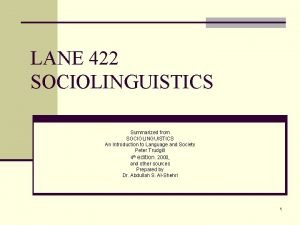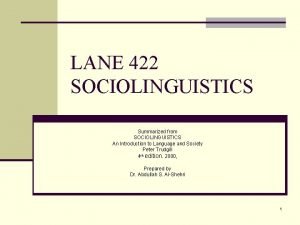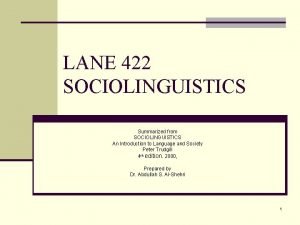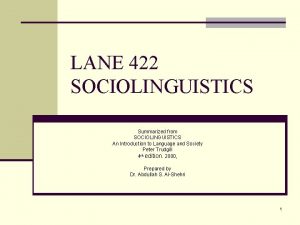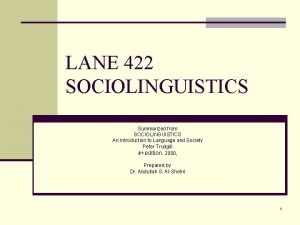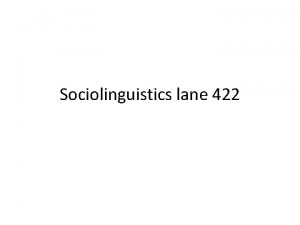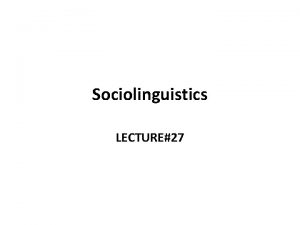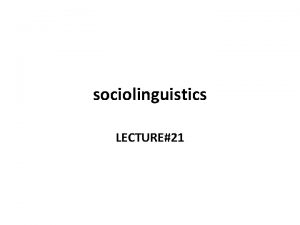LANE 422 SOCIOLINGUISTICS Summarized from SOCIOLINGUISTICS An Introduction














- Slides: 14

LANE 422 SOCIOLINGUISTICS Summarized from SOCIOLINGUISTICS An Introduction to Language and Society Peter Trudgill th 4 edition. 2000, Prepared by Dr. Abdullah S. Al-Shehri 1

Chapter 5 Language and Context 2

In this chapter, we will see that. . n Language varies not only according to the social characteristics of speakers – such as social class, ethnic group, and gender which we have already discussed – but also according to the social context in which speakers find themselves. n The same speaker uses different linguistic varieties in different situations and for different purposes. n The totality of linguistic varieties used in different situations for different purposes by a particular community or a particular speaker is called that community’s, or the speaker’s linguistic or verbal repertoire. n Many social factors can come into play in controlling which variety from the speaker’s linguistic repertoire is actually to be used on a particular occasion. 3

Registers n A register is a style level in a language. When we speak we automatically locate ourselves on a specific stylistic level. This can vary depending on the situation in which we find ourselves. For example when talking to a close friend one would most likely use a different register than when one is holding a public address. n A register can also mean a specialized variety of language: The register of law, for example is different from the register of medicine, which in turn is different from the register of engineering, and so on. n Registers are usually characterized almost entirely by vocabulary differences, either by using particular words or by using words in a particular sense. n One of the aims of education is to introduce students to the registers (or terminologies) of particular subjects. n Registers are an example of particular kind of language being produced by a particular kind of social context. n Many other factors connected with the social context in which language is being used will also have a linguistic effect. One of the most important of these is formality. 4

Formality n ‘Formality’ is not easy to define. This is because formality subsumes very many factors including situation, social formality, kinshiprelationship, politeness, seriousness, and so on. n Nevertheless, most people have a good idea of the relative formality and informality of particular linguistic variants in their own language. n For example, it is not difficult for people who know English well to see in what way the following pair of sentences differs: - Father was somewhat fatigued after his lengthy journey. - Dad was pretty tired after his long trip. n These two sentences mean the same thing, but they differ in terms of their formality. The first sentence is relatively formal and the second sentence is relatively informal. n Varieties of language which differ from one another in this way are called styles. 5

Styles n Styles can be ranged on a continuum ranging from the very formal to the very informal. n Styles of this type in English (and in many other languages) are for the most part characterized by vocabulary differences, but also by syntactic and phonetic differences. n Vocabulary which is at the extremely informal end of the continuum is known as slang. n In some languages styles may be rather more inflexible than in English. In Javanese, for example, there are several distinct and discrete speech ‘levels’, or stylistic varieties (with lexical and grammatical differences) which are used in different social contexts and have names that are well-known in the community. For example: n ‘Are you going to eat rice and cassava now’? can be said in the following three distinct styles depending on the social context: n n n Menapa pandjenengan badé dahar sekul kalijan kaspé sanenika? Napa sampéjan adjeng neda sekul lan kaspé saniki? Apa kowé arep mangan sega lan kaspé saiki? 6

The Addressee’s Context n One important feature of social context which may well have an effect on the formality of the language used is the ‘context’ of the person spoken to, and in particular the role relationship and relative statuses of the participants in a discourse. n For example, speech between individuals of unequal rank (due to status in an organization, social class, age, or some other factor) is likely to be less relaxed and more formal than that between equals. n In certain languages definite rules may exist as to which linguistic forms may or may not be used. n A good example of this is the different forms of address that are produced by different degrees of status difference or intimacy. n Different degrees of politeness and deference may be required, and these are signaled linguistically. n The connotations of English address-forms, such as sir, Mr. Smith, Fredrick, Fred, mate, are all different. Each has different stylistic implications, and the rules for their usage, are quite complex. 7

Further Stylistic Complications n In other non European linguistic communities further complications arise, since it is not only names or address pronouns (such as French tu – vous; German du – sie) that are involved. n In both Japanese and Korean, for example, the context of the person addressed can, in addition to particular address-forms, produce rather considerable grammatical and lexical variation as well, depending on the relationship between, and the relative statuses of the two people involved. n A Korean speaker, for instance, may have to choose one out of six different verb suffixes, depending on their relationship to the person addressed. 8

Thus. . n In most if not all linguistic communities, differences in social context having a bearing on formality lead to the use of different styles. n These styles may be relatively discrete, as appears to be the case in Javanese, or not. n Styles can be characterized through differences in vocabulary, including address forms and pronouns, and in grammar and pronunciation. n We can regard these styles as being varieties within dialects, since they still show characteristics of the speaker’s regional and social background. 9

However. . n In certain other language communities, style shifting must take place between different dialects or varieties. n In these cases, one dialect will occur in formal situations, and another in informal situations. n For example, native speakers of Lowland Scots dialects may switch, in relatively formal situations, to Standard English: n n Scots English dialect: I’ve kenned yon man eight years. Standard Scots Eng. : I’ve known that man eight years. 10

In Other Parts of the World. . n Switching styles is carried out on a much larger and more institutionalized scale. This sociolinguistic situation has been called diglossia. n Diglossia is a particular kind of language standardization where two distinct varieties of a language exist side by side throughout the speech community. n Each of the two varieties is assigned a definite social function. n The two linguistic varieties in a diglossic situation are considered by speakers to be discrete, with some exceptions. n The two varieties have overt recognition in the community, and have commonly known and used labels. n Examples of languages which are diglossic and where there exist a high variety and a low variety are Swiss German, Arabic and Tamil. 11

Diglossia n The most important feature of the diglossic situation is probably the specialization of a function of the two varieties. n The high variety is used in sermons, formal letters, political speeches, university lectures, news broadcasts, newspaper editorials and ‘high’ poetry. n The low variety, on the other hand, is used in conversation with family and friends, radio serials, political and academic discussions, political cartoons and ‘folk’ literature. n The ‘high’ variety has no native speakers and in all cases have to be learned in school. n Generally speaking, the high variety has greater prestige than the low variety, and is often regarded as more beautiful, even if it is less intelligible. 12

Diglossia (Continued) n The differences between the ‘high’ and ‘low’ varieties in diglossic languages is usually rather more serious than in non diglossic languages. n Such differences are highly noticeable at the lexical, grammatical and phonological levels. n At the lexical level, many pairs of words may occur, referring to common objects or concepts, where the meaning is roughly the same, but where the usage of one item rather than another immediately indicates high or low variety. n For example, in Arabic the use of the form [ra? a: ] ‘to see’ indicates the high (classical) variety, and the use of the form [ŝa: f] indicates the low (colloquial) variety. 13

Language Switching n In many communities around the World, the verbal repertoire of speakers may contain totally unrelated languages. n In Luxemburg, where switching occurs between German and French, language-switching will take place, like style- or dialectswitching, according to the social context. n In India, the verbal repertoire of many educated speakers in Delhi, for instance, comprises English, Urdu and Hindi, including very different styles of Hindi. 14



